Knee Ankle Foot Orthosis
Total Surface Bearing/Thermoplastic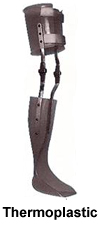
Indications
- Any time significant changes in volume are not anticipated
Contraindications
- When significant changes in volume are anticipated
Advantages
- Increases control
- Reduces pressures on the skin
- More comfort
- Considerably lighter
- High durability/weight ratio
- Easy to clean / hygienic
- Can easily be chance to different shoes
Disadvantages
- Does not accommodate for changes in volume as well as conventional systems
SC KAFO
A stance phase control KAFO is the same as a standard KAFO design with the exception of the knee locking mechanism. “Stance phase control” refers to a knee joint that is stable or will not buckle while in the stance phase of gait while still allowing for free knee flexion during the swing phase of gait. This property allows for a much more normal walking pattern for someone who still needs support in keeping the knee from buckling. The indications for this type of brace vary depending on what specific knee joint is used. The following pages provide the different Stance Phase Control options that are available currently as well as a description of each knee’s indications and contraindications.
FreeWalk Stance Control Knee/Ankle System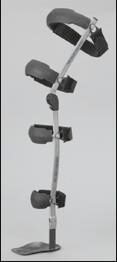
The FreeWalk KAFO revolutionizes the way your patients walk.
Our innovative design creates a more natural gait cycle by locking during stance phase and unlocking during swing phase. The automatic lock is initiated by knee extension, and is only released to swing freely when a knee extension moment and dorsiflexion occur simultaneously in terminal stance. The result is a more secure, efficient gait that also reduces the incidence of typical gait compensations.
FreeWalk 170K1=L/R-80 (fits 80 kg or 175 lbs)
FreeWalk 170K1=L/R-120 (fits 120 kg or 265 lbs)
- Stance control technology allows for a more efficient gait by locking when stance stability is required and unlocking for free swing.
- Locking mechanism control cable is contained in the tubular stainless steel sidebar, which is both strong and low profile.
- Knee joint automatically locks prior to initial contact whenever joint is fully extended.
- Secure on slopes and stairs: Joint requires simultaneous extension moment and 10% dorsiflexion to release making it safe for ascents and descents.
- Open frame design makes the FreeWalk easy to don and doff and keeps it cooler than most alternatives.
- Your measurements and our custom fabrication assure your patient of an excellent fit.
- The FreeWalk’s tubular steel construction and unique knee mechanism require a special fabrication process. Otto Bock C-Fab has special tools and expertise needed to fabricate this orthosis. We look forward to meeting your central fabrication needs.
Indications
Isolated quad weakness, polio, post-polio, MS, unilateral paralysis, incomplete spinal cord injury, trauma.
Horton Technology Inc. – The Horton SCOKJ
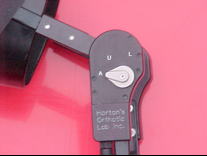 Designed for patients with weak or absent quadriceps and varying degrees of knee instability. This lightweight orthosis will allow patients to regain their mobility and assist them in a more energy-efficient ambulation. The Horton SCOKJ blocks flexion at any degree.
Designed for patients with weak or absent quadriceps and varying degrees of knee instability. This lightweight orthosis will allow patients to regain their mobility and assist them in a more energy-efficient ambulation. The Horton SCOKJ blocks flexion at any degree.
Prevents knee collapse regardless of flexion
Lightweight materials
High Durability
Indications:
Isolated quad weakness / absence
Unilateral leg paralysis / paresis
Increased stability for FR AFO candidates
Increased stability for offset knee KAFO wearers
Increased stability for free knee KAFO wearers
Increased stability for solid ankle / PF stop AFO wearers
Contraindications:
Total loading > 225 pounds /102k
Significantly impaired cognition, balance, or motivation
Uncorrectable Genu Varum / Valgum > 10 degrees
Knee flexion contracture > 10 degrees
Biological knee joint > 5 degrees off line of progression in
swing phase
The flexion lock is released automatically in late stance phase
by a mechanical linkage, either by reduction of heel weightbearing
or ankle motion. In addition to its automatic mode, the Horton
SCOKJ can be locked in full extension or always unlocked for
specific activities requiring those extremes.
For more info on this knee contact the following or contact Capstone Orthopedic to get one made!
www.stancecontrol.com
Info@stancecontrol.com
Horton Technology Inc.
Innovations In Orthotics and Prosthetics
5220 West 12th * Little Rock, AR. 72204
Basko Healthcare – Fillauer – The Swing Phase Lock (SPL)
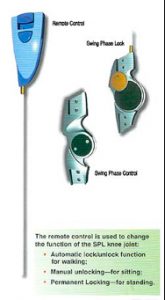 The SPL uses a simple internal pendulum mechanism to lock and unlock the knee depending on the angle of the joint in the sagittal plane. During gait, the device locks just prior to heel strike for support during stance, and unlocks the knee at heel off in preparation for swing. This action is intended to mimic the normal physiologic action of the knee extensors. Because the mechanism is position dependent, it does not rely on heel loading or cabling as in other designs.
The SPL uses a simple internal pendulum mechanism to lock and unlock the knee depending on the angle of the joint in the sagittal plane. During gait, the device locks just prior to heel strike for support during stance, and unlocks the knee at heel off in preparation for swing. This action is intended to mimic the normal physiologic action of the knee extensors. Because the mechanism is position dependent, it does not rely on heel loading or cabling as in other designs.
The SPL is intended for patients with partial or total paralysis of the knee extensors and can be used as a KO or KAFO, with or without articulating ankle joints. It is not recommended for those with more proximal impairment of the hip musculature. To use the SPL, the patient must be able to initiate swing thru. If there is no active hip extensor at heel strike, (hip extensor failure, foot flexor failure) a dorsiflexion stop may be used to help unlock the knee. Users must have fair or better (grade 3) hip flexor strength to use the SPL. Also, the SPL orthotic knee system has been designed only as a non-weight bearing joint and should not be used in any weight bearing orthoses.
Contraindications:
– Knee Flexion Contracture
greater than 10 degrees
– Central Paralysis
– Hip Flexion Contracture
– Hip Musculature Involvement
– Poor Balance/Coordination
– Knee Hyperextension greater than 10 degrees
The Swing Phase Lock has three modes of operation controlled by a proximal remote push-button switch:
1) Automatic Lock/ Unlock
2) Manual Unlock
3) Manual Lock
The different modes allow the patient to select automatic lock for walking, unlock for sitting, or lock for standing.
The SPL operates on a unique pendulum mechanism, which rocks fore and aft in response to momentum and gravity. Just before heel strike, the pendulum moves backwards, locking the knee in extension for weight-bearing. At the end of stance phase, the pendulum swings forward again, releasing the lock to allow flexion in swing phase. For additional patient safety, an extension moment is required both to lock and unlock the joint.
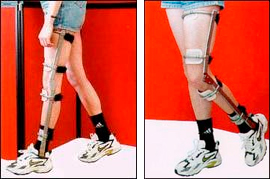 The UTX
The UTX
Knee-Ankle-Foot Orthosis with Intelligent Knee Stabilization System
- The UTX Swing Knee Ankle Foot Orthosis, was designed and developed by Dr. Nils Van Leerdam, of Ambroise Holland bv.
- It is a lightweight 1.65 – 1.98 lbs (750-900 grams) KAFO that stabilizes the knee during the stance phase of gait but enables knee flexion during swing phase.
- At the end of swing phase, as the knee reaches full extension, a ratchet engages to stabilize the knee.
- A cable runs inside the distal side member from the ankle joint to the knee joint. At the end of stance phase as the ankle dorsiflexes, this cable linkage is used to unlock and destabilize the knee.
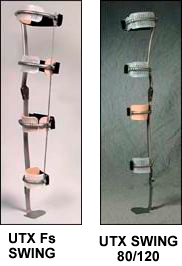 Clinical Indications:
Clinical Indications:
- Quadriceps weakness as a result of Poliomyelitis, Multiple Sclerosis, CVA, Femoral Nerve and Spinal Cord Injuries.
- Genu Recurvatum.
- Successful users will typically have hip extensor strength (Power 3) and passive ankle dorsiflexon.
UTX Swing 80/120:
- Body weight up to 80kg (175lbs) – UTX Swing 80
- Body weight up to 120kg (265lbs) – UTX Swing 120
UTX Fs Swing for added Control in Coronal Plane:
- The UTX Fs Swing is designed to control unstable genu valgum.
- Body weight up to 100kg (220lbs)
The E-Knee
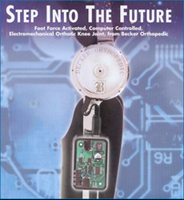 The “E-Knee”, with the “E” standing for “electronic”, joint represents the first practical marriage of the computer age with long leg braces. The E-Knee combines force plates and microprocessor technology to create a knee joint that locks and unlocks with foot contact on the floor. The locking mechanism is on the outside of the knee joint and is powered by a lithium battery. The joint also utilizes a unique clutch lock, which will lock in any position when triggered. The knee joint is linked to a footplate, which contains multiple sensors. Through a careful calibration process the foot-plate/knee joint mechanism is programmed to lock at the proper time, when the foot touches the ground. It is then further programmed to unlock the knee and allow for free swing as your gait cycle progresses.
The “E-Knee”, with the “E” standing for “electronic”, joint represents the first practical marriage of the computer age with long leg braces. The E-Knee combines force plates and microprocessor technology to create a knee joint that locks and unlocks with foot contact on the floor. The locking mechanism is on the outside of the knee joint and is powered by a lithium battery. The joint also utilizes a unique clutch lock, which will lock in any position when triggered. The knee joint is linked to a footplate, which contains multiple sensors. Through a careful calibration process the foot-plate/knee joint mechanism is programmed to lock at the proper time, when the foot touches the ground. It is then further programmed to unlock the knee and allow for free swing as your gait cycle progresses.
Note that Becker Othopedic also has some other new and exciting options for orthotic knee joints including other stance phase control options.
